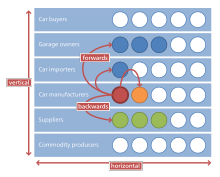Horizontal integration

| Marketing |
|---|
Horizontal integration is the process of a company increasing production of goods or services at the same part of the supply chain. A company may do this via internal expansion, acquisition or merger.[1][2][3]
The process can lead to monopoly if a company captures the vast majority of the market for that product or service.[3]
Horizontal integration contrasts with vertical integration, where companies integrate multiple stages of production of a small number of production units.
Horizontal alliance[]
Horizontal integration is related to horizontal alliance (also known as horizontal cooperation). However, in the case of a horizontal alliance, the partnering companies set up a contract, but remain independent. For example, Raue & Wieland (2015) describe the example of legally independent logistics service providers who cooperate.[4] Such an alliance relates to competition.
Aspects[]
Benefits of horizontal integration to both the firm and society may include economies of scale and economies of scope. For the firm, horizontal integration may provide a strengthened presence in the reference market. It may also allow the horizontally integrated firm to engage in monopoly pricing, which is disadvantageous to society as a whole and which may cause regulators to ban or constrain horizontal integration.[5]
Media terms[]
Media critics, such as Robert W. McChesney, have noted that the current trend within the entertainment industry has been toward the increased concentration of media ownership into the hands of a smaller number of transmedia and transnational conglomerates.[6] Media is seen to amass in center where wealthy individuals have the ability to purchase such ventures (e.g., Rupert Murdoch).[citation needed]
That emerged are new strategies for content development and distribution designed to increase the "synergy’ between the different divisions of the same company. Studios seek content that can move fluidly across media channels.[7]
Examples[]
An example of horizontal integration in the food industry was the Heinz and Kraft Foods merger. On 25 March 2015, Heinz and Kraft merged into one company, the deal valued at $46 Billion.[8][9] Both produce processed food for the consumer market.
On 9 December 2013, Sysco agreed to acquire US Foods but on 24 June 2015, the federal judge ruled against the deal saying that such merger would control 75% of the U.S. foodservice industry and that will stifle competition.[10] It would have been horizontal integration, as both distribute food to restaurants, healthcare, and educational facilities.
On 16 November 2015, Marriott International announced that it would acquire Starwood for $13.6 billion, creating the world's largest hotel chain.[11] The merger was finalized on 23 September 2016.[12]
AB-Inbev acquisition of SAB Miller for $107 Billion which completed in 2016, is one of the biggest deals of all time.[13]
On 1 November 2017, Centurylink bought Level 3 Communications for $34 billion, and incorporated Level 3 as part of Centurylink.
On 14 December 2017, The Walt Disney Company announced a $52.4 billion bid in stock to acquire 21st Century Fox along with its bulk of assets, which included the famed 20th Century Fox film studio and other assets such as FX Networks and 30% stake in Hulu. Both companies produced and distributed films and television series, as well as each owning a 30% stake in Hulu.[14]
See also[]
- Economies of scale
- Horizontal market
- List of economics topics
- List of management topics
- List of marketing topics
- Monopoly
- Strategic management
- Target market
- Vertical integration
References[]
- ^ "Horizontal Integration Definition". economicshelp.org. Retrieved 5 February 2016.
- ^ "Definition of Horizontal Integration in a Supply Chain". smallbusiness.chron.com. Retrieved 5 February 2016.
- ^ Jump up to: a b "horizontal integration". businessdictionary.com. Retrieved 5 February 2016.
- ^ Raue, Jan Simon; Wieland, Andreas (2015). "The interplay of different types of governance in horizontal cooperations" (PDF). The International Journal of Logistics Management. 26 (2): 401–423. doi:10.1108/IJLM-08-2012-0083. hdl:10398/4de0953a-3920-409a-b63a-60342c976528.
- ^ "Horizontal Integration - What It Really Means For Marketing - Ardor Media Factory". Ardor Media Factory. Retrieved 19 February 2016.
- ^ Thorburn, David and Jenkins, Henry (eds)(2002) Rethinking Media Change, MIT Press, Cambridge, Massachusetts, pp.283.
- ^ Thorburn, David and Jenkins, Henry (eds)(2003) Rethinking Media Change, MIT Press, Cambridge, Massachusetts, pp.284.
- ^ https://www.nytimes.com/2015/03/26/business/dealbook/kraft-and-heinz-to-merge.html?_r=0
- ^ http://time.com/3770785/heinz-kraft-merger/
- ^ "Sysco Ends Plans to Merge With US Foods". WSJ. Retrieved 5 February 2016.
- ^ Nycz-Conner, Jennifer (16 November 2015). "Marriott International to acquire Starwood Hotels & Resorts Worldwide in $12.2 billion deal". American City Business Journals.
- ^ Trejos, Nancy (23 September 2016). "Marriott, Starwood merger is complete, loyalty programs will reciprocate". USA Today. Retrieved 24 September 2016.
- ^ https://www.forbes.com/sites/taranurin/2016/10/10/its-final-ab-inbev-closes-on-deal-to-buy-sabmiller/#1aa8b829432c
- ^ Nolter, Chris (December 14, 2017). "Disney Acquires Most of Fox's Assets in Blockbuster $52.4 Billion Stock Deal". TheStreet.com. Archived from the original on December 15, 2017. Retrieved December 15, 2017.
- Market structure
- Business terms
- Strategic management
- Marketing strategy